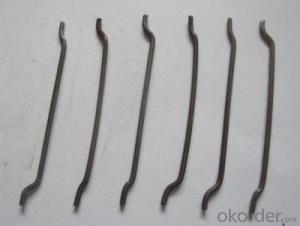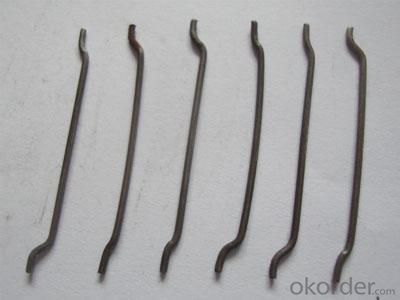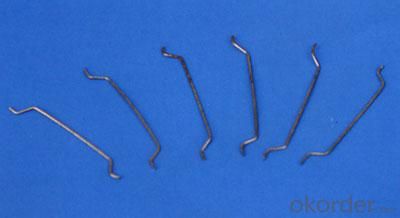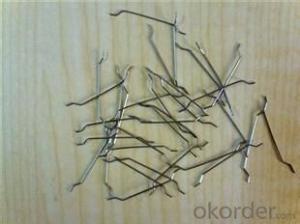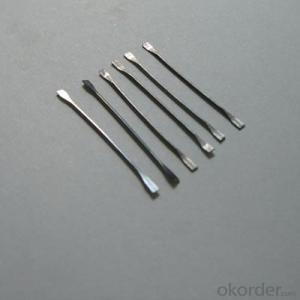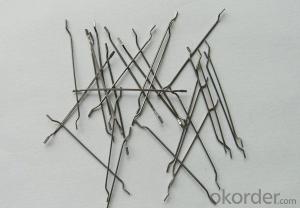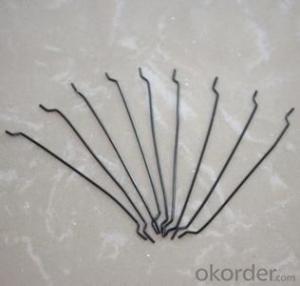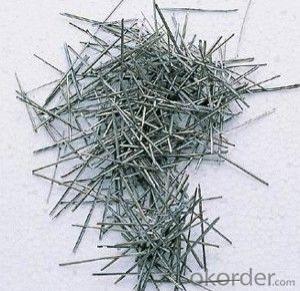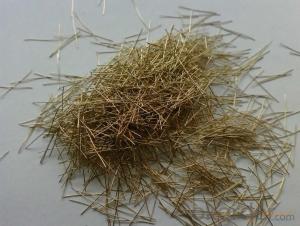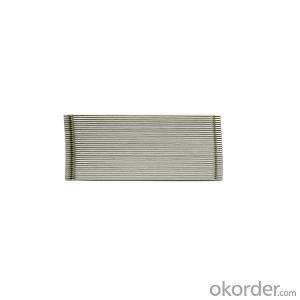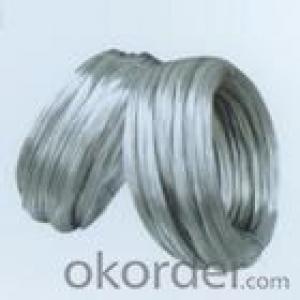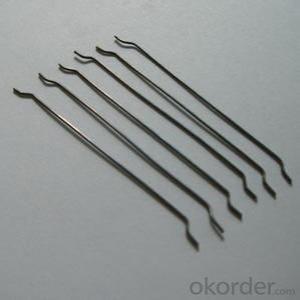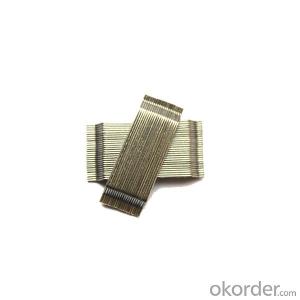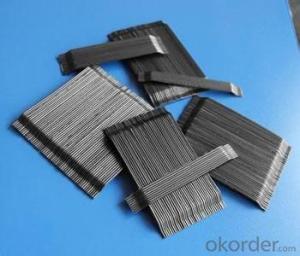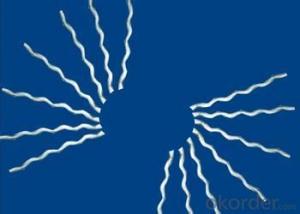Melt Extract Stainless Steel Fiber Concrete Steel Fiber Low Carbon CNBM Company
- Loading Port:
- Tianjin
- Payment Terms:
- TT OR LC
- Min Order Qty:
- 2000 kg
- Supply Capability:
- 250000 kg/month
OKorder Service Pledge
OKorder Financial Service
You Might Also Like
Quick Details
Place of Origin: China (Mainland)
Material: Steel
material: steel wire
application: for concrete reinforcement
appearance: clean and bright
shape: steel fiber
Product features
concrete steel fiber is specifically to enhance concrete in its hardened state ,the uniform distribution of steel fiber throughout the concrete greatly improve concrete bonding and tensile strength ,additionally it provides exceptional load stability and durability ,as reliable and efficient concrete reinforcement material
it is widely ued in buildings ,bridges ,thin roo engineering ,highway etc.
Specifications
length :20-60mm
diameter :0.5MM-1.2MM
tensile strengh:>1100Mpa
| diameter | length | tensile strength | |
| 0.5mm | 35mm | 1100Mpa | |
| 0.75 | 60mm | 1100Mpa | |
| 0.9 | 60m | 1100Mpa |
others can do according to your requirement
Picture
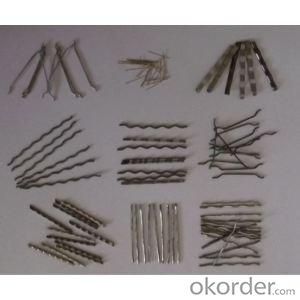
steel fiber for concrete
FAQ
we can produce any type steel fiber and of course we can make production according to your requirement
we have specilize in this field for almost 10 years ,with good quality and competitive price
- Q: Can melt extract stainless steel fiber be used in pre-stressed concrete elements?
- Yes, melt extract stainless steel fiber can be used in pre-stressed concrete elements. The use of stainless steel fibers in pre-stressed concrete can enhance its mechanical properties, such as improving crack resistance and reducing shrinkage. These fibers also provide increased durability and resistance to corrosion, making them suitable for use in pre-stressed concrete elements.
- Q: Can melt extract stainless steel fiber enhance the resistance of concrete to acid attack?
- Yes, melt extract stainless steel fiber can enhance the resistance of concrete to acid attack. Stainless steel fibers are known for their high corrosion resistance and durability. When added to concrete, they form a network that improves the strength and performance of the material. In the case of acid attack, concrete is prone to deterioration and damage. Acids can react with the calcium hydroxide in the cement paste, leading to the dissolution of the concrete matrix and a decrease in its strength. However, when stainless steel fibers are incorporated into the concrete mix, they create a barrier that prevents the acid from directly contacting the cement paste. The stainless steel fibers act as a reinforcement, enhancing the mechanical properties of the concrete. They provide additional strength and toughness, making the concrete more resistant to acid attack. The fibers also help in distributing the stress and reducing crack formation, further protecting the concrete from acid penetration. Additionally, the corrosion resistance of stainless steel fibers ensures that they remain intact even in aggressive environments. This means that they can continue to provide reinforcement and protection to the concrete for an extended period. Overall, melt extract stainless steel fiber can significantly enhance the resistance of concrete to acid attack by reinforcing the material, preventing direct contact between acids and the cement paste, and improving the durability of the concrete.
- Q: What is the effect of melt extract stainless steel fiber on the modulus of resilience of concrete?
- The effect of melt extract stainless steel fiber on the modulus of resilience of concrete is generally positive. Stainless steel fibers are commonly added to concrete mixtures to enhance its durability and mechanical properties. The modulus of resilience measures the ability of a material to absorb and store energy when deformed elastically, and then release it upon unloading. Adding melt extract stainless steel fibers increases the modulus of resilience of concrete by improving its ductility and toughness. The fibers act as reinforcements within the concrete matrix, creating a network that helps to distribute stress and prevent crack propagation. This reinforcement effect enhances the ability of the concrete to withstand impact, cyclic loading, and other external forces, thereby increasing its resilience. Moreover, stainless steel fibers have a high tensile strength and corrosion resistance, which further contribute to the improvement of concrete's modulus of resilience. These fibers can effectively prevent the formation and expansion of cracks, enhancing the overall structural integrity and longevity of the concrete. In summary, the inclusion of melt extract stainless steel fiber in concrete positively impacts its modulus of resilience by increasing its ductility, toughness, and ability to absorb and release energy. This results in a more durable and resilient concrete structure, capable of withstanding various types of loading and environmental conditions.
- Q: What is the effect of melt extract stainless steel fiber on the shrinkage and cracking of concrete?
- The primary way in which melt extract stainless steel fiber affects the shrinkage and cracking of concrete is by improving its overall tensile and flexural strength. When added to concrete, these fibers act as reinforcement, thereby reducing the instances of shrinkage and cracking. The drying process in concrete leads to shrinkage, which can result in cracks. However, the addition of melt extract stainless steel fibers helps enhance the concrete's tensile strength, thereby decreasing the likelihood of shrinkage cracks. These fibers create a network within the concrete, evenly distributing forces and stresses, which in turn mitigates the potential for cracking due to shrinkage. Furthermore, melt extract stainless steel fibers can enhance the concrete's resistance to cracking caused by external factors, such as temperature changes, heavy loads, or structural movements. By reinforcing the concrete, these fibers increase its ability to withstand bending and tensile forces, ultimately minimizing the occurrence of cracks. Moreover, the inclusion of melt extract stainless steel fibers improves the durability and longevity of concrete structures. By reducing shrinkage and cracking, these fibers contribute to the overall integrity and stability of the concrete, ensuring it can withstand various environmental and load conditions for an extended period. In conclusion, adding melt extract stainless steel fiber to concrete positively impacts shrinkage and cracking by improving its tensile strength, reducing the occurrence of shrinkage-related cracks, and enhancing its resistance to external forces. Ultimately, this results in more durable and long-lasting concrete structures.
- Q: Can melt extract stainless steel fiber be used in tunneling and underground construction?
- Yes, melt extract stainless steel fiber can be used in tunneling and underground construction. Stainless steel fibers are known for their high tensile strength, corrosion resistance, and durability, which makes them an ideal choice for reinforcement in concrete structures. In tunneling and underground construction, where the structures are subjected to high levels of stress, such as impact and vibration, the use of stainless steel fiber can enhance the structural integrity and increase the overall lifespan of the construction. Additionally, stainless steel fibers also provide improved crack resistance and fire resistance, which are crucial in underground environments. Overall, melt extract stainless steel fiber is a reliable and effective reinforcement material for tunneling and underground construction projects.
- Q: Difference between cement manhole cover and steel fiber manhole cover
- The material is different, the thickness is different, the structure is different, the weight is also different.
- Q: Does melt extract stainless steel fiber increase the resistance to cracking in concrete?
- Yes, melt extract stainless steel fiber does increase the resistance to cracking in concrete. Stainless steel fibers are commonly added to concrete mixes as reinforcement to improve its tensile strength and prevent cracking. The addition of these fibers helps to distribute stress and reduce shrinkage, thus increasing the overall resistance to cracking in the concrete. Melt extract stainless steel fibers are particularly effective in enhancing the concrete's resistance to cracking due to their high tensile strength, durability, and superior bonding properties.
- Q: What is the effect of melt extract stainless steel fiber on the crack propagation in concrete?
- The effect of melt extract stainless steel fiber on crack propagation in concrete is primarily to enhance the crack resistance and improve the overall durability of the concrete structure. When stainless steel fibers are added to concrete, they form a three-dimensional reinforcement network that helps to distribute the stress more evenly throughout the concrete matrix. By dispersing the load and reducing the concentration of stress at vulnerable points, such as cracks or weak zones, the stainless steel fibers effectively inhibit crack propagation. The fibers act as micro-reinforcements within the concrete, bridging the cracks and preventing them from propagating further. The unique properties of stainless steel fibers, such as high tensile strength, corrosion resistance, and ductility, make them particularly effective in enhancing the crack resistance of concrete. Unlike other types of fibers, stainless steel fibers are able to withstand high tensile stresses and maintain their integrity even under extreme conditions, such as freeze-thaw cycles or chemical exposure. Furthermore, the melt extract process used in manufacturing stainless steel fibers ensures a high aspect ratio, which means that the fibers have a large surface area to interact with the surrounding concrete matrix. This increased interfacial bond between the fibers and the concrete matrix further enhances the crack resistance. Overall, the addition of melt extract stainless steel fibers to concrete significantly improves its ability to withstand cracking and enhances its durability. This can lead to increased service life, reduced maintenance costs, and improved safety for concrete structures in various applications, such as buildings, bridges, pavements, and tunnels.
- Q: Can melt extract stainless steel fiber be used in tunnel rehabilitation projects?
- Certainly, melt extract stainless steel fiber can be utilized in tunnel rehabilitation endeavors. The distinctive attributes of stainless steel fibers render them an exceptional alternative for reinforcing concrete in tunnel rehabilitation. These fibers possess exceptional resistance to corrosion, a crucial factor given the inhospitable and damp conditions within tunnels. Furthermore, stainless steel fibers exhibit remarkable tensile strength, thereby boosting the durability and structural integrity of the concrete. Moreover, the melt extract process guarantees that the fibers possess a polished surface, facilitating improved adhesion with the concrete matrix. Consequently, this leads to enhanced crack resistance, diminished shrinkage, and heightened flexural and impact strength in the reconditioned tunnel structure. All in all, melt extract stainless steel fiber is a dependable and efficient material for reinforcing tunnel rehabilitation projects.
- Q: Can melt extract stainless steel fiber be used in tunnel segments?
- Melt extract stainless steel fiber is indeed applicable for tunnel segments. It is a common practice to incorporate stainless steel fibers into concrete mixtures for the purpose of enhancing the material's mechanical properties and increasing its durability. By incorporating stainless steel fibers, the strength and crack resistance of concrete segments in tunnel construction can be significantly improved, thereby minimizing the likelihood of structural failures. Furthermore, stainless steel fibers offer superior resistance to corrosion, making them a suitable choice for tunnel segments that may face moisture or aggressive environments. Consequently, melt extract stainless steel fiber can be utilized effectively in tunnel segments to enhance their structural integrity and prolong their lifespan.
Send your message to us
Melt Extract Stainless Steel Fiber Concrete Steel Fiber Low Carbon CNBM Company
- Loading Port:
- Tianjin
- Payment Terms:
- TT OR LC
- Min Order Qty:
- 2000 kg
- Supply Capability:
- 250000 kg/month
OKorder Service Pledge
OKorder Financial Service
Similar products
Hot products
Hot Searches
Related keywords
